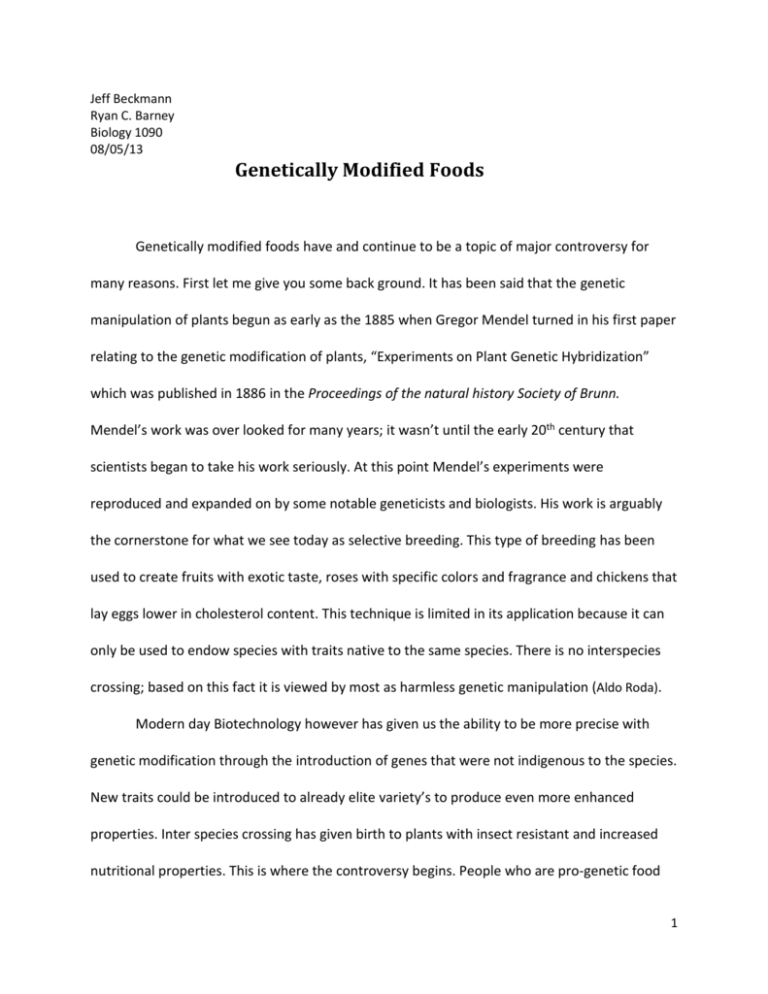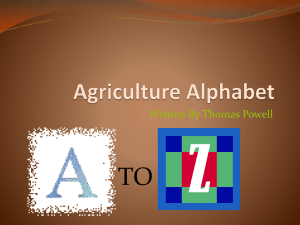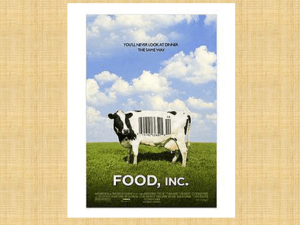Biology 1090 final paper - Jeffery S. Beckmann eportfolio
advertisement

Jeff Beckmann Ryan C. Barney Biology 1090 08/05/13 Genetically Modified Foods Genetically modified foods have and continue to be a topic of major controversy for many reasons. First let me give you some back ground. It has been said that the genetic manipulation of plants begun as early as the 1885 when Gregor Mendel turned in his first paper relating to the genetic modification of plants, “Experiments on Plant Genetic Hybridization” which was published in 1886 in the Proceedings of the natural history Society of Brunn. Mendel’s work was over looked for many years; it wasn’t until the early 20th century that scientists began to take his work seriously. At this point Mendel’s experiments were reproduced and expanded on by some notable geneticists and biologists. His work is arguably the cornerstone for what we see today as selective breeding. This type of breeding has been used to create fruits with exotic taste, roses with specific colors and fragrance and chickens that lay eggs lower in cholesterol content. This technique is limited in its application because it can only be used to endow species with traits native to the same species. There is no interspecies crossing; based on this fact it is viewed by most as harmless genetic manipulation (Aldo Roda). Modern day Biotechnology however has given us the ability to be more precise with genetic modification through the introduction of genes that were not indigenous to the species. New traits could be introduced to already elite variety’s to produce even more enhanced properties. Inter species crossing has given birth to plants with insect resistant and increased nutritional properties. This is where the controversy begins. People who are pro-genetic food 1 modification place emphasis on increased nutritional value, heartiness and higher crop yields. Greater nutrition and higher crop yields could help reduce human malnutrition and world hunger. These foods also have a huge potential to increase profit margins and lower the cost of production, which in turn allow for larger distribution areas making it much easier to address issues like world hunger (Aldo Roda). The opposition exacerbates the fact that these GMO’s could possibly create more food allergies, and inter species gene transfers that could be harmful to human health. As well as the potential negative environmental effects, such as killing populations of bees with insect resistant strains of crops or “terminator seeds.” These seeds are genetically altered to produce only infertile seeds, which farmers are unable to replant. Bees studied after collecting pollen from these plants and were shown to have digestive tract diseases such as amoeba and nosema disease. After studies of these bee’s autopsies, the most alarming trait is the lower intestine and stingers have a discolored to black vs. the normal opaque color, synonymous with colon cancer in humans (Amos). Without the bees there will not be as much pollination within natural populations of plants that keep other bugs and animals alive; creating a devastating effect on the eco system. Another issue is the possible transfer of antibiotic resistant genes from GM foods to the micro flora in the human intestines. If this did happen it could be directly harmful to human health. Also there are concerns with GM crops interbreeding with different types of weeds creating weeds resistant to poison creating or “super weeds” (Belk, Maier, Marieb, Mallatt, and Wilhelm). 2 On farming side of things there are a few different ways GM seeds work on the market. First in regards to small farming outfits, the standard thinking with GM seeds is that they will increase crop yields and reduce the need for expensive and harmful chemicals. With this in mind it would seem that GM seeds are the answer to solving struggling small farms problems. These claims of reduced cost and increased crop yields are not always the case. For instance, some studies show GM crops have a lower overall crop yield when compared to standard crops. When humans began domesticating plants we selected plants based on high yield. Plants only have so much energy to work with, so when we breed plants to use most of their energy on producing seed they have less energy for defense mechanisms; which makes insecticide’s necessary for keeping crops healthy. Therefore, when insect fighting genes are reintroduced back into crops we take away some of the energy being used to produce seeds, which results in a lower yield (GMOs: Friend or Foe). As it stands GM seeds are made for corporate farms. The agro- tech companies are not addressing the needs of small farming outfits. Cross contamination with GMOs is a huge problem for small farmers; because, small organic farmers cannot sell their crops under an organic label if GM seeds are thought to have mingled with the organic ones. Trying to sell under an organic label in this instance is punishable by the government. Even worse if a competitor of the small farmer finds one of its patented genes in the small farms crops the farmer can be faced with a major lawsuit. Small farmers can’t afford these risks, so the only option left for them is to buy the GM crops and suffer the higher price for seed, reduced yield, and lower selling price for their product. Which in many cases is putting small farming outfits out of business (GMOs: Friend or Foe). 3 The benefits of GMOs tend to weigh primarily on the side of larger corporate farms; because, they have the resources to buy the seeds and to hire agricultural scientists to ensure the seeds are being optimized. The use of GMOs also benefits large farms by preserving the soil. Because GMOs need less water than their counter parts and large farms use machines to plant seeds without tilling; this combination greatly reduces soil degradation. In the end GMOs give large farms the ability to yield more crops for a lower price widening the gap between large and small farms further monopolizing the industry (GMOs: Friend or Foe). In conclusion, there are two opposing sides to the controversy. The Pro GM crops side states that GM crops have the potential to help reduce world hunger with the production of larger, heartier crops. As well as help decrease malnutrition in humans with crops that have greater nutritional values. On the anti-GM side it is said that they have many negative characteristics; such as the potential to cause serious damage to our ecosystem by killing bees and creating super weeds resistant to poison. GM crops could also destroy local farming economies by the use of seeds that cannot be replanted which in turn will create a monopoly for GM seed production companies. Furthermore on a personal note I will try to avoid purchasing GM food in the future whenever it is convenient. However, if it becomes a hassle I will not worry about it, because there have not been any conclusive studies to prove that they are harmful to humans. Also I do feel that they have more negative effects on the environment than positive ones so in the future I believe we should take more steps create an environmentally conscious form of GM crop, or just stop using them if they are destroying the ecosystem. 4








